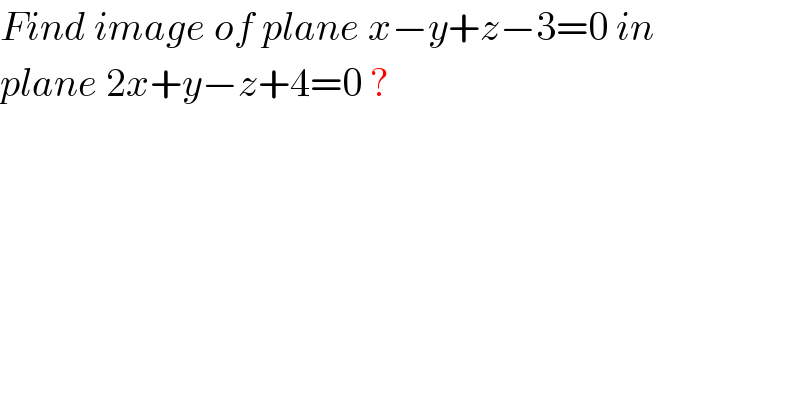Question Number 45417 by rahul 19 last updated on 12/Oct/18

$${Find}\:{image}\:{of}\:{plane}\:{x}−{y}+{z}−\mathrm{3}=\mathrm{0}\:{in}\: \\ $$$${plane}\:\mathrm{2}{x}+{y}−{z}+\mathrm{4}=\mathrm{0}\:? \\ $$
Answered by MrW3 last updated on 13/Oct/18

$${since}\:{both}\:{planes}\:{are}\:{perpendicular} \\ $$$${to}\:{each}\:{other},\:{the}\:{image}\:{is}\:{itself},\:{i}.{e}. \\ $$$${x}−{y}+{z}−\mathrm{3}=\mathrm{0} \\ $$$$ \\ $$$${but}\:{I}'{ll}\:{show}\:{you}\:{a}\:{general}\:{way}\:{to}\:{find} \\ $$$${the}\:{image}\:{in}\:{a}\:{plane}. \\ $$$$ \\ $$$${the}\:{image}\:{of}\:{point}\:\left({X},{Y},{Z}\right)\:{in}\:{plane} \\ $$$${ax}+{by}+{cz}+{d}=\mathrm{0} \\ $$$${is}\:{point}\:\left({U},{V},{W}\right)\:{with} \\ $$$${U}={X}−\frac{\mathrm{2}{a}\left({aX}+{bY}+{cZ}+{d}\right)}{{a}^{\mathrm{2}} +{b}^{\mathrm{2}} +{c}^{\mathrm{2}} } \\ $$$${V}={Y}−\frac{\mathrm{2}{b}\left({aX}+{bY}+{cZ}+{d}\right)}{{a}^{\mathrm{2}} +{b}^{\mathrm{2}} +{c}^{\mathrm{2}} } \\ $$$${W}={Z}−\frac{\mathrm{2}{c}\left({aX}+{bY}+{cZ}+{d}\right)}{{a}^{\mathrm{2}} +{b}^{\mathrm{2}} +{c}^{\mathrm{2}} } \\ $$$$ \\ $$$${now}\:{we}\:{take}\:{a}\:{point}\:{P}\left({u},{v},{w}\right)\:{on}\:{the}\:{plane} \\ $$$${x}−{y}+{z}−\mathrm{3}=\mathrm{0} \\ $$$${Its}\:{image}\:{in}\:{the}\:{plane} \\ $$$$\mathrm{2}{x}+{y}−{z}+\mathrm{4}=\mathrm{0} \\ $$$${is}\:{P}'\left({p},{q},{r}\right). \\ $$$${we}\:{can}\:{also}\:{say}\:{P}\left({u},{v},{w}\right)\:{is}\:{the}\:{image} \\ $$$${of}\:{P}'\left({p},{q},{r}\right).\:{using}\:{formula}\:{above}\:{we}\:{get} \\ $$$$ \\ $$$${u}={p}−\frac{\mathrm{2}×\mathrm{2}\left(\mathrm{2}{p}+{q}−{r}+\mathrm{4}\right)}{\mathrm{2}^{\mathrm{2}} +\mathrm{1}^{\mathrm{2}} +\left(−\mathrm{1}\right)^{\mathrm{2}} } \\ $$$$\Rightarrow{u}={p}−\frac{\mathrm{2}\left(\mathrm{2}{p}+{q}−{r}+\mathrm{4}\right)}{\mathrm{3}} \\ $$$${similarly} \\ $$$$\Rightarrow{v}={q}−\frac{\mathrm{1}\left(\mathrm{2}{p}+{q}−{r}+\mathrm{4}\right)}{\mathrm{3}} \\ $$$$\Rightarrow{w}={r}−\frac{\left(−\mathrm{1}\right)\left(\mathrm{2}{p}+{q}−{r}+\mathrm{4}\right)}{\mathrm{3}} \\ $$$$ \\ $$$${since}\:{u}−{v}+{w}−\mathrm{3}=\mathrm{0} \\ $$$${p}−\frac{\mathrm{2}\left(\mathrm{2}{p}+{q}−{r}+\mathrm{4}\right)}{\mathrm{3}}−{q}+\frac{\left(\mathrm{2}{p}+{q}−{r}+\mathrm{4}\right)}{\mathrm{3}}+{r}+\frac{\left(\mathrm{2}{p}+{q}−{r}+\mathrm{4}\right)}{\mathrm{3}}−\mathrm{3}=\mathrm{0} \\ $$$$\Rightarrow{p}−{q}+{r}−\mathrm{3}=\mathrm{0} \\ $$$${or} \\ $$$$\Rightarrow{x}−{y}+{z}−\mathrm{3}=\mathrm{0} \\ $$$${this}\:{is}\:{the}\:{expected}\:{result}. \\ $$
Commented by rahul 19 last updated on 13/Oct/18
Thank you so much sir ! ☺️��
In the formula you posted , if we need to find foot of perpendicular then this factor 2 will not come . right?
Commented by MrW3 last updated on 13/Oct/18

$${yes}\:{sir}. \\ $$$${foot}\:{point}\:\left({U}',{V}',{W}'\right) \\ $$$${U}'=\frac{{X}+{U}}{\mathrm{2}}=\frac{{X}}{\mathrm{2}}+\frac{{X}}{\mathrm{2}}−\frac{{a}\left({aX}+{bY}+{cZ}+{d}\right)}{{a}^{\mathrm{2}} +{b}^{\mathrm{2}} +{c}^{\mathrm{2}} } \\ $$$$\Rightarrow{U}'={X}−\frac{{a}\left({aX}+{bY}+{cZ}+{d}\right)}{{a}^{\mathrm{2}} +{b}^{\mathrm{2}} +{c}^{\mathrm{2}} } \\ $$
Commented by MrW3 last updated on 13/Oct/18

$${this}\:{formula}\:{is}\:{easy}\:{to}\:{remember} \\ $$$${and}\:{be}\:{used}\:{for}\:{example} \\ $$$${to}\:{find}\:{the}\:{distance}\:{of}\:{point}\:\left({X},{Y},{Z}\right)\:{to} \\ $$$${a}\:{plane}: \\ $$$${d}=\sqrt{\left({X}−{U}'\right)^{\mathrm{2}} +\left({Y}−{V}'\right)^{\mathrm{2}} +\left({Z}−{W}'\right)^{\mathrm{2}} } \\ $$$$=\frac{\mid{aX}+{bY}+{cZ}+{d}\mid}{{a}^{\mathrm{2}} +{b}^{\mathrm{2}} +{c}^{\mathrm{2}} }\sqrt{{a}^{\mathrm{2}} +{b}^{\mathrm{2}} +{c}^{\mathrm{2}} } \\ $$$$=\frac{\mid{aX}+{bY}+{cZ}+{d}\mid}{\:\sqrt{{a}^{\mathrm{2}} +{b}^{\mathrm{2}} +{c}^{\mathrm{2}} }} \\ $$
Commented by rahul 19 last updated on 13/Oct/18

$${ok}\:{sir}. \\ $$
